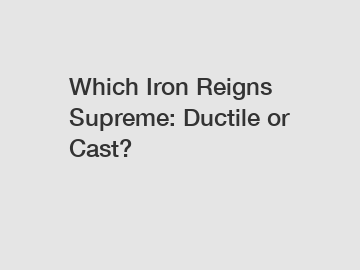Which Iron Reigns Supreme: Ductile or Cast?
Which Iron Reigns Supreme: Ductile or Cast?
Iron is a versatile and indispensable material in various industries, especially in engineering and construction. When it comes to choosing the right type of iron for a specific application, however, the decision often boils down to two main contenders: ductile iron and cast iron. While both types of iron have their merits and flaws, in the battle for supremacy, it is clear that ductile iron reigns supreme.
Ductile iron, also known as nodular iron, is a type of iron that has superior strength and flexibility compared to cast iron. Its mechanical properties are achieved through an additional step in the production process called "nodularization." This process involves introducing nodularizing agents, such as magnesium or cerium, during the molten iron stage, which encourages the formation of spherical graphite nodules within the iron matrix. These nodules increase the strength and ductility of the iron, making it more resistant to cracking and deformation.

In contrast, cast iron is a type of iron that is brittle and prone to cracking. It is characterized by its high carbon content, which gives it excellent castability but compromises its mechanical properties. The presence of graphite flakes within the iron matrix weakens its structure, making it less suitable for applications that require high strength or dynamic loading. Cast iron is commonly used in applications where its high thermal conductivity and wear resistance are more important than its mechanical properties, such as in engine blocks, pipes, and cookware.
The superiority of ductile iron over cast iron can be further illustrated by examining their respective properties. Ductile iron has a higher tensile strength, yield strength, and elongation at break compared to cast iron. This means that it can withstand greater forces and deformations without fracturing. Moreover, ductile iron has a better impact resistance and fatigue strength, making it more durable in applications subject to repeated loading or impacts.
The nodularization process in ductile iron production also contributes to its superior corrosion resistance. The spherical graphite nodules act as an additional barrier to the diffusion of corrosive agents, protecting the iron matrix from degradation. In contrast, cast iron is more susceptible to corrosion due to the presence of graphite flakes, which creates preferential sites for pitting and crevice corrosion.
The choice between ductile iron and cast iron has significant implications for the performance and longevity of engineering structures and components. Ductile iron's superior mechanical properties and corrosion resistance make it ideal for applications such as pipes, valves, and fittings in water and wastewater systems. Its high strength and impact resistance also make it suitable for automotive components, such as crankshafts and suspension parts. In contrast, cast iron's excellent castability and thermal conductivity make it preferable for applications such as engine blocks and brake rotors.
In conclusion, the battle between ductile iron and cast iron for supremacy is easily won by ductile iron. Its superior mechanical properties, corrosion resistance, and versatility make it the preferred choice for many engineering and construction applications. However, it is important to consider the specific requirements of each application and select the appropriate type of iron accordingly. After all, the reign of ductile iron is a testament to the continuous pursuit of innovation and improvement in the field of materials engineering.
Contact us to discuss your requirements of korea valve manufacturer, China rising stem gate valves company, China ball valve with pneumatic actuator factory. Our experienced sales team can help you identify the options that best suit your needs.

Comments
0